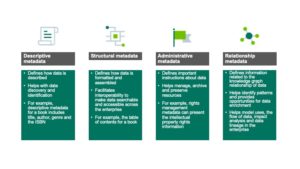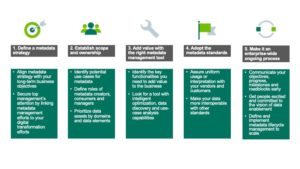Metadata management is a cross-organizational agreement on how to define informational assets. The first blog of this series discusses how businesses are increasingly realizing the need for metadata management to drive data governance, compliance, collaboration and higher data quality. This blog focuses on the best practices for metadata management.
The importance of metadata
Metadata is important because it maximizes the value of information assets through the necessary context and the consistent use of terminology.
Metadata is data in the context of “who, what, where, why, when, and how.” It answers questions like:
- Who created the data?
- What is its privacy level?
- Where is it stored?
- Why is it in a specific format?
- When was it created?
- How is it stored?
Metadata is like the nutritional information on a bar of chocolate, where the product is presenting you with information about itself. From a data point of view, it enriches the usefulness of the product and its packaging, even if it doesn’t make the chocolate any tastier.
The types of metadata
Metadata is often directly available from the sources that create and maintain data. It may be automatically extracted from the operations (e.g. processing and accessing of data) or manually created. A digital photo, for example, routinely provides the date and time. You can tag the image with more keywords of who captured it, the place or the event, or the subject of the photo. With metadata, this tagging helps uniquely identify the image so that you can share it with the right people and for the right purpose.
Metadata is categorized by the purpose it serves in the business environment. The four types of metadata are descriptive, structural, administrative and relationship.
1. Descriptive
Descriptive metadata defines how data is described and can be used for discovery and identification. For example, descriptive metadata for a book includes title, author, genre, and the ISBN. Keywords are also considered as descriptive metadata.
2. Structural
Structural metadata refers to the structure of the data, how it is formatted and how it is assembled. The table of contents for a book is an example of structural metadata. Structural metadata facilitates interoperability and ensures that with the defined metadata schemas or protocols, resources can be searched and accessed across the enterprise.
3. Administrative
Administrative metadata presents important instructions about data. It may list the restrictions applicable to a file, including who can access it. Administrative metadata has a critical role in managing, archiving, and preserving resources. Rights management metadata, as an example, can present the intellectual property rights information.
4. Relationship
Relationship metadata defines information related to the knowledge graph relationship of data, describing how it is linked to other resources that participate together in a process or analysis. Relationship metadata helps model uses, the flow of data, impact analysis and data lineage in the enterprise. Relationship metadata helps identify patterns and provides opportunities for data enrichment.
Metadata helps you discover, classify, describe, archive, control and manage data.

Top 5 best practices for effective metadata management
Effective metadata management provides rich context to enterprise data assets, powering their efficient use and reuse. It is also a requirement for government agencies across the world to ensure data governance. According to the 2020 Dataversity Report on Trends in Data Management, many organizations place increasing value on data governance and metadata management to build a data landscape that informs about all the data assets in the organization. Early adoption of best practices can go a long way in ensuring complete success.
1. Define a metadata strategy
Metadata management begins with defining a metadata strategy to provide a foundation for assessing the long-term value. Gartner Research recommends that metadata management initiatives must clearly support the organization’s business vision and resulting business objectives.
Some critical questions to ask to arrive at a metadata strategy are:
- For what type of information do you want to manage metadata, now and in the future?
- For what type of information are you not able to manage metadata?
- What are your current and prospective use cases for metadata?
- What are your use cases for showing relationships between metadata objects?
A robust metadata strategy can offer alignment with business objectives, identify high priority activities and help evaluate an implementation methodology. It is also important to link metadata management efforts to digital transformation efforts, such as digitization, omnichannel enablement, or enterprise-resource-planning modernization as these efforts typically depend on data availability and quality.
2. Establish scope and ownership
Identifying the scope is always a best practice to channel the efforts in the right direction and focus on high-priority activities.
- Identify your potential use cases for metadata – data governance, data quality, data analysis, risk and compliance are some of the top use cases.
- Capture functional metadata requirements – examples include resource discovery, digital identification or archiving.
- Specify all possible ways you will use the proposed solution – metadata capture and storage, integration, publication and more.
- Define the scope considering essential requirements and critical use cases.
Your organization will have various roles of metadata creators, consumers, and managers. Defining clear ownership and responsibilities ensures accountability for metadata quality. Well-articulated roles will help you optimize resource utilization. Critical data is no more than 10 to 20 percent of total data in most organizations. Prioritize data assets and focus metadata leadership accordingly.
3. Add value with the right metadata management tool
Dataversity report on Emerging Trends in Metadata Management states that more than 69% of organizations look for search and storage as the top functionalities for metadata management tools. Based on the metadata strategy and scope that you have defined, you can identify the key functionalities you need. The first blog in this series discusses the critical capabilities of fully automated metadata management tools.
4. Adopt the metadata standards
The recently published DoD Data Strategy emphasizes metadata tagging and common metadata standards for data-centric organizations. Common metadata standards assure uniform usage or interpretation with your vendor and customer communities.
Metadata standards have been evolving over the years and they vary in levels of details and complexity. The general metadata standards like the Dublin Core Metadata Element Set apply to broader communities and make your data more interoperable with other standards. The subject-specific metadata standards, on the other hand, help search data more easily. For example, the ISO 19115 standard works well for the geospatial community. You can evaluate which standards align the best with your use cases and your communities.
5. Make it an enterprise-wide ongoing process
Any best practices list will not be complete if you do not engage the people. Start from the top and onboard all to get total support across the organization. When people are excited and committed to the vision of data enablement, they’re more likely to help ensure that data is high quality and safe. Communicate your objectives, progress, milestones and roadblocks early to ensure that you get inputs and cooperation from all the stakeholders. Champion enterprise-wide collaboration to create valuable metadata and design efficient processes.
Metadata management is much more than a one-time activity. Plan for an ongoing process that supports flexibility and scales as your organization grows. Define and implement metadata lifecycle management so that you are ready for changes and enhancements. Conducting regular audits helps health assessment and identifying areas of improvement.
Top 5 best practices for effective metadata management

The Gartner research note observes that the use of ML in metadata management tools can be helpful for automated tagging, profiling and semantic reconciliation. With the right strategy and the right tool, you will not only optimize metadata management but also start your journey to Data Intelligence.
In the next blog, we’ll focus on how metadata management frameworks can impact your organization’s data strategy.



